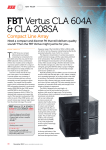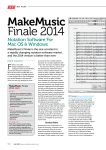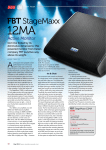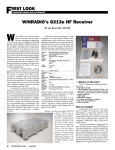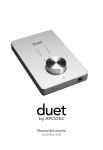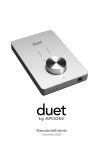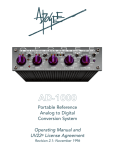Download Apogee Quartet User manual
Transcript
on test Apogee Quartet USB Audio Interface For Mac This sleek four-channel interface and monitor controller embodies all the quality and style we’ve come to expect from Apogee. Paul White A pogee have both extremes of the Mac-compatible audio interface market covered, from their desktop Duet and its siblings at one end of the range, to their large-scale Symphony systems at the other. That being the case, it makes perfect sense for them to come out with something that sits comfortably between the two; something that’s still affordable to the quality-conscious home recording operator, but with enough I/O to handle ensemble recording and, if need be, surround mixing. That’s exactly what the Apogee Quartet £1259 pros • High-quality converters and mic preamps. • Compact, elegant format. • Integrated monitor controller and headphone amp. • Maestro software allows the setting up of two different zero-latency monitor mixes. Audio compatible DAW running on an Intel Mac (1.5GHz CPU or above). Quartet is, but that’s not all it is, as it has an integrated monitor controller too. As the name suggests, the Quartet is a four-channel interface, and while this may not look exactly generous to those who need to mic up a drum kit, a pair of ADAT (S/MUX) ports allow eight further channels to be added at sample rates of up to 96kHz, using one of the many expander units available, including Apogee’s own Ensemble. This takes the maximum input channel count to 12, which, being realistic, is enough for most small studio recording projects, even if they include a drum kit. If no expansion is required, the Quartet can run at sample rates up to 192kHz. The Quartet will work with any Core Overview The wedge-shaped, die-cast aluminium hardware is sleek, surprisingly weighty, and a perfect complement to the Duet and One units, whose user interfaces share the same single-knob paradigm. Its ‘QuickTouch’ touch pads and displays are set into a single black panel, and the whole design exudes a stylish simplicity that is both elegant and practical. Even the non-slip base is incredibly effective — you really have to push hard to make this unit move once it’s positioned on a smooth surface. The Quartet features two colour screens, similar in style to those used in the Duet, for metering and status display (levels, cons • Adding an expander unit provides eight more inputs, but no more outputs. summary The Quartet is a logical addition to the Apogee interface range, and is well suited to the quality-conscious project studio owner who requires no more than 12 simultaneous inputs. 156 The Quartet’s back panel features four ‘combi’ XLR/jack inputs, six analogue outputs on quarter-inch jack sockets, ADAT input ports, USB ports for both MIDI and connection to the host computer, word clock output, a ground terminal and cable clamp, and an input for the external power supply. November 2012 / w w w . s o u n d o n s o u n d . c o m grouping, phase, muting, phantom power and Soft Limit). The leftmost QuickTouch pads are numbered one to four for input selection. Two more buttons select speaker or headphone level adjustment and there’s simultaneous metering for all four inputs and the output levels. The single controller knob, with its integral push-switch, is used to adjust all the variable functions and is suitably large to use as a main volume control. Apogee make a big deal about the low latency that can be achieved with the Quartet: at 96kHz and at a buffer size of 32 samples, latency is just 3.6ms — a full millisecond less than the equivalent Firewire 400 setup. I used a buffer size of 64 samples at 44.1kHz for most of my tests and still couldn’t perceive any delay. Also of note is Soft Limit, Apogee’s proprietary circuitry for subtly squashing the peaks of loud signals to produce a more analogue-like saturation when the maximum signal level is approached. This can be enabled or disabled on an individual channel basis via the included (via download) Maestro 2 software. The Maestro 2 control software is an integral part of the package. It has a straightforward, single-window interface and is compatible with current Mac operating systems, as well as Snow Leopard. Here you can configure the system, select the input type, enable or disable Soft Limit on the inputs, and use Maestro’s mixer section for low-latency monitoring. Assigning speakers to touch pads and configuring the front-panel A, B and C buttons is also done here. Connectivity The Quartet has six balanced output jacks that can be used in pairs as three stereo speaker feeds, as a 5.1 feed, or as sends to external equipment. There’s also a separate headphone output located on the right-hand side of the case, which has full level control via the front panel, and that can be fed from its own monitor mix if required. A-D/D-A conversion is courtesy of Apogee’s respected conversion technology, and the designers have paid a lot of attention to providing really good quality mic preamps to do their converters justice. These digitally controlled analogue preamps, each fitted with a ‘combi’ XLR/jack input socket, offer a very wide gain range of 0 to 75dB and have click-free transitions as the gain is adjusted. Phantom power at the full 48 Volts is available for capacitor mics as you’d expect, and is independently switchable for each input. The USB port marked MIDI is configured only for Core MIDI devices, not for general USB functions, presumably to conserve bandwidth. While you could plug directly into your computer for MIDI over USB, this approach saves using up a port on your Mac. There’s a separate mini-USB socket for connection to the host computer using the included cable. Apogee have settled on the USB 2 protocol for connection to the host computer, as in its current incarnation it is actually faster than Firewire 400, and although USB 3 offers more bandwidth, the designers tell me this wouldn’t result in any performance benefits. USB also seems likely to have a longer life-span than Firewire now that Thunderbolt is on the scene. Other rear-panel connections include an input for the included power supply and a word clock output on a standard BNC connector. A separate ground terminal (useful for laptop-based systems) also includes a cable clip for the power lead. The two ADAT ports allow S/MUX operation to double up the sample rate to a maximum of 96kHz and are inputs w w w . s o u n d o n s o u n d . c o m / November 2012 157 on test Apogee Quartet only — you don’t get any additional outputs with an expander connected. The Quartet always provides the master clock when an expander unit is connected, so the expander must be set to external sync and, as the ADAT connection only runs one way, a word clock cable must be connected between the two. As with other Apogee devices, the clock is designed to offer a high degree of stability, though how well an external device will lock to this depends very much on its own clock recovery circuitry. Still, there’s no point buying Apogee if you’re planning to hook it up to something cheap and nasty! Operation When you plug in the Quartet, it is recognised by Core Audio and basic operation is possible, as the assignable touch pads are preconfigured to Dim, Mute and Clear Meters (the latter clearing the red ‘Overs’ indicators at the top of each meter indicating that a clip has occurred since they were last reset). You will, however, need to download the Maestro control software from the Apogee web site in order to make any changes or to switch on the phantom power. I mention this only because I received the physical unit for review shortly before getting a link to the software, so I had a while to play with it. When the QuickTouch pads are used for input, output or speaker-set selection, the currently selected parameter is the one adjusted via the controller knob. For example, if you select an input, the knob adjusts the preamp gain, whereas if you select a speaker, it adjusts the speaker volume. An LED ‘halo’ highlight ring appears around the currently active touch pad, so you always know what you’re adjusting. The three rightmost touch pads (labelled A, B and C and located above the rotary control) are all user assignable, so you can decide what you need them to do from a menu of options shown in the Maestro software: sum to mono, dim the levels, switch speaker sets or clear the ‘overs’ indicator in the meters. Up to three sets of stereo speakers can be connected, or all the outputs may be used Alternatives In this price and quality range, the main competition probably comes from RME, but it’s also worth looking at Focusrite, as they provide good-quality mics amps in their interfaces. If you can cope with fewer channels, I’d consider the Focusrite Forte, reviewed elsewhere in this issue. If single-knob operation is your thing, it’s also worth looking at the MOTU Track 16. 158 The Mixer page in Apogee’s Maestro 2 control software. to drive a single 5.1 system. You can also mix and match the functionality by, for instance, having two sets of speakers connected and then using the remaining two outputs to feed an outboard processor or provide further monitor mixes. When an input’s gain is being adjusted, the meter area on the front panel changes to a gain-knob display, with further status indicators showing Grouping, Soft Limit and Polarity. Similarly, adjusting a speaker’s level shows a rotary display for the level value and a speaker symbol, although a ‘Home Lock’ option prevents the view from changing. Once you stop turning the knob, the display automatically reverts to metering after a few seconds. These displays are pin sharp. With the Maestro software’s Input panel open, you can also select the input type as Line +4dBu, Line -10dBv, Mic or Instrument. The appropriate symbol for each is shown above the input meters, and when a stereo recording is being made, channels can be grouped so that their gains are adjusted together. Polarity invert can also be activated, along with Soft Limit, which is, again, independent for each input. The Maestro Mixer window is where you can set up low-latency source monitoring if required, although, as mentioned, with a buffer setting of 64 I didn’t notice latency being a problem. The Mixer page actually shows two mixers, one above the other. This means, for example, that if you need two different monitor mixes while recording, one can be assigned to feed the speakers and one the headphones. Each mixer allows you to balance any of the live inputs with the sound coming back from your DAW, so as long as you remember to turn down the monitor level of any tracks you’re currently recording in your DAW’s mixer, you can have latency-free monitoring. Separate tabs open pages for viewing Inputs, Outputs, Device Settings, Output November 2012 / w w w . s o u n d o n s o u n d . c o m Routing, Mixer and System Setup. Device Settings is where you select what those three right-hand ABC buttons should control, and you can also set the push-switch in the rotary encoder to mute the speakers, the phones, or both. The Quartet comes with a quick-start guide, and a comprehensive user manual that details the setup procedure for all the mainstream DAWs is available from the Apogee web site, but if you’ve ever used an audio interface before, you should have no trouble finding your way around the Quartet. Performance My tests were made using Logic Pro. Selecting the interface is done in the usual Logic way, via audio preferences, which is also where you set the buffer size. You can name the inputs and outputs within Logic if you feel the need to. In other DAWs, you can usually access such settings directly from within Apogee’s own control panel, but currently this doesn’t work for the Quartet within Logic. While, on paper, there are better-specified converters if you’re willing to pay for them, it is probably fair to say that the quality of Apogee’s is so good that we’re approaching the realm where any further improvements are just for the benefit of the test gear, rather than human ears. Their converters also have a reputation for sounding musical. With cheaper interfaces, working at 96kHz often yields a noticeable improvement in smoothness, as it places fewer demands on their digital filter sections, but in the case of the Quartet, even working at 44.1kHz produces creditably smooth and classy results. In fact, on a recorded speech test I was hard pushed to hear any significant sonic difference between working at 44.1kHz and 96kHz. The mic preamps are also worthy of mention, as they are exceptionally clean System Requirements • Intel Mac with 1.5GHz processor or faster, 2GB RAM minimum, 4GB recommended, OS 10.6.8 or higher. • The Quartet works with any Core Audio compatible application including Logic, GarageBand, MainStage, Final Cut, Pro Tools, Live, Digital Performer, Studio One, Cubase and Nuendo. and sound very focused, producing outstanding results even with dynamic microphones. Soft Limit is a nice touch, too, as it helps avoid unpleasant-sounding overloads while lending a slight analogue character to sounds as they approach the maximum level the converters can handle. With this switched on, it is very difficult to overcook the signal level. I found the touch interface so intuitive that I hardly noticed that there’s only one knob to adjust everything. Integration with the Maestro software is smooth and seamless, and using it to activate phantom power, polarity-invert switches and suchlike is actually less of a chore than bending down to find the physical switches on a conventional interface that might be stuck in a rack an arm’s reach away. I checked out the ADAT side of the unit using an external eight-channel RME unit, and this locked to the Quartet with no fuss. Its inputs showed up as numbers 5 to 12 in the system and I was in business. Impressions We live in a world where the top professional studios use pretty much the same computer/software systems as those of us further down the food chain. The main area in which pro studios are better specified than project studios is in terms of what’s hooked up to the front and back ends of the computer, and the audio interface is a very big part of that. Yes, you can buy an audio interface with twice the I/O at half the price of the Quartet, but the converters and mic preamps will probably not sound nearly as good. On many of them, you can hear digital crosstalk and interference from the USB connection grumbling away in the background if you need to run the mic amps at a high gain setting, as you might when using a ribbon mic. I tested for this on the Quartet. Recording ambient room noise with a passive ribbon mic at very high gain settings, and then normalising the result, showed up only room sound and a little honest electronic hiss. There have been occasions when trying this test with lesser interfaces has produced a result reminiscent of a fax machine being fed through a coffee grinder. When judging the value of something like the Quartet, you have to factor in what it might cost you to add decent mic preamps to a more mundane interface, and also the cost of a separate monitor controller. You also have to consider logistics: where is everything going to fit? The Quartet provides a compact solution capable of true ‘big boys’ performance, and the minuscule quality difference between it and those truly ££ £1258.80 including VAT. esoteric devices TT Sonic Distribution costing 10 times +44 (0)845 500 2 500. as much really is in EE [email protected] the realm of ‘But WW www.sonic-distribution.com will it affect record WW www.apogeedigital.com sales?’ w w w . s o u n d o n s o u n d . c o m / November 2012 159 Mix with the best! “Besides the excellent interviews and fascinating, in‑depth recording and mixing articles, I can always depend on Sound On Sound for complete, unbiased reviews of the latest pro‑audio gear. “ Bob Clearmountain, engineer, producer and mixer, Grammy Award winner (Bruce Springsteen, The Rolling Stones, Paul McCartney, INXS) “As a professional I admire Sound On Sound as one of the most trusted and credible sources of inspiration and information.” Jack Joseph Puig, mixer, producer, Grammy Award winner (Rolling Stones, U2, Mary J Blige, Black Eyed Peas) The World’s Best Recording Technology Magazine This article was originally published in Sound On Sound magazine, November 2012 edition follow us on Twitter find us on Facebook go to the SOS YouTube channel visit the SOS forum Subscribe and Save Money! Visit our subscriptions page at www.soundonsound.com/subscribe for more information on the Sound On Sound App go to: www.soundonsound.com/app Sound On Sound, Media House, Trafalgar Way, Bar Hill, Cambridge, CB23 8SQ, United Kingdom Email: [email protected] Tel: +44 (0) 1954 789888 Fax: +44 (0) 1954 789895 All contents copyright © SOS Publications Group and/or its licensors, 1985-2012. All rights reserved. The contents of this article are subject to worldwide copyright protection and reproduction in whole or part, whether mechanical or electronic, is expressly forbidden without the prior written consent of the Publishers. Great care has been taken to ensure accuracy in the preparation of this article but neither Sound On Sound Limited nor the publishers can be held responsible for its contents. The views expressed are those of the contributors and not necessarily those of the publishers.







